

Seattle Cosmic saw its first Theme Night in 3D Game Night, devoted to three-dimensional board games. 3D Game Night was inspired by Frank Branham's review of Torres for the Boulder Games newsletter, in which he states,
My collection is chock full of attempts to make a decent game where players move in 3D space. Very few of them are interesting. The exceptions being AXIOM (Seventh Seal), and STAGE 5 (Milton Bradley).
He goes on to say that Torres is a wonderful 3D game too. Frank is an expert on obscure games, and if he says that these are the only decent 3D boardgames ever made, who am I to argue? However, he made a slight error: the game he calls "Stage 5" is actually titled "Strata 5". Fortunately, after weeks of searching fruitlessly for "Stage 5" on eBay, I accidentally ran across a listing for Strata 5 and purchased the game. The trade lists at the wonderful BoardgameGeek made it possible for me to track down a copy of Axiom, and then all I had to do to make the evening "complete" was ask Tim Higgins to bring his copy of Torres. This whole process of rounding up games for game night very much resembled a game of Spiel & Deal, about which more below.
Present Saturday were seven people: Marty and Ron Hale-Evans (that's me), Tim Higgins, Kisa Gryphon, Karl Erickson, John Braley, and New Guy Alan Ferguson. Alan is a friend of Karl and John's who was visiting Seattle to see the one-man play about Buckminster Fuller, The History and Mystery of the Universe. Karl and John went to the play with him; they are all Synergeticists and geometers, and 3D Game Night was therefore especially appealing to them. Alan is from Calgary, Alberta, Canada, so Saturday was not only Seattle Cosmic's first Theme Night, it was also (to the best of my knowledge) our first visit from an alien.
Tim and Karl arrived first, around 7:00. While we were waiting for the others, we started a game of Spiel & Deal. John and Alan arrived around 7:40, before we had a chance to do more than read the rules, so we aborted Spiel & Deal and broke into two groups, one playing Axiom and one playing Torres.
Karl and New Guy Alan paired off to try Axiom. The best places to learn about this rare and curious game are a review at The Game Cabinet and the Axiom page at BoardgameGeek, where you can also see who is selling and trading this game. Suffice it to say that the game is played by moving pawns around the top and sides of an ever-changing "board" made up of cubes that can be connected together or broken apart. The object is to land your pawn (or "Sceptre") on a cube (or "Cube") that has one of your opponent's pawns on it. Because of the three-dimensionality of the board, Karl and Alan found this task almost as hard as playing Go on a torus -- there's always somewhere else for your piece to go.
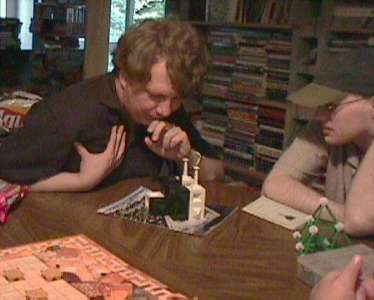
The Synergeticists had just been to Math 'n' Stuff, a very cool educational game and toy store in Seattle (just how cool can be seen by the fact that they can use apostrophes correctly!), so they brought all sorts of 3D construction toys to play with. Here's Karl fidgeting while Alan thinks some more:
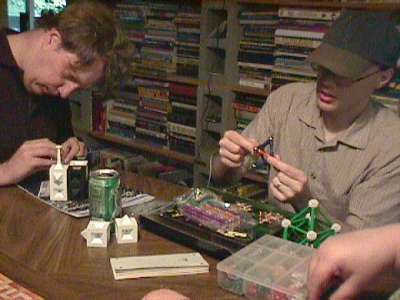
Karl and Alan played for a long time, then decided they had misinterpreted a crucial rule. The rule states rather ambiguously: "The players take turns to move, whereby each turn involves a player moving either an 'Axiom' Cube or a 'Sceptre' of their chosen colour." They had been interpreting this rule to mean they had to move Sceptres of their own colour but could move Cubes of either colour. They had such trouble when they interpreted the rules in this fashion that they called their first game a draw, and started a second game in which they could only move Cubes of their own colour; it was a much better game that way.
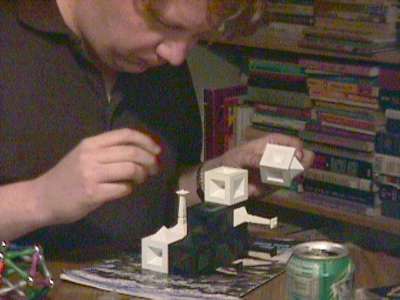
Below is a closeup of the Axiom "board". The Axiom rules suggest you place the board on a magazine, because it must be rotated frequently, and Sceptres are never placed on the bottom. One Axiom edition comes with a mat for this purpose; mine does not, so Karl grabbed a copy of Abstract Games Magazine from the bookshelf behind him. You can see it below. How appropriate! I wonder if they will ever print articles on Axiom strategy.
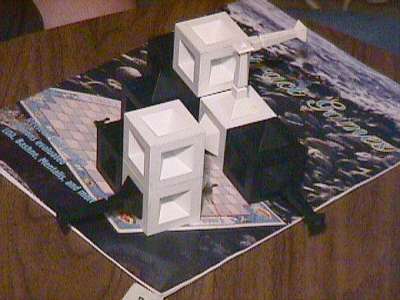
Alan proved the victor, so was awarded a large plastic Tiger Salamander from Archie McPhee. That's right -- we're giving toys instead of chocolate as prizes again for a while.
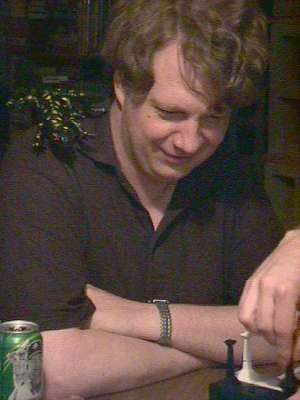
General impressions: Alan loved the game, and said that by the second game he was learning new strategies and tactics constantly. Karl, however, thought the game lacked clarity, in Robert Abbott's sense: the potential for players to look far ahead strategically. However, the Game Cabinet review linked above claims that it takes a few games to really "get it", and Alan's experience seems to support that.
Meanwhile, John, Tim, Marty, and I played a game of Torres. It was the second time Tim and I had played, and the first time Marty and John had. We played the basic variant.
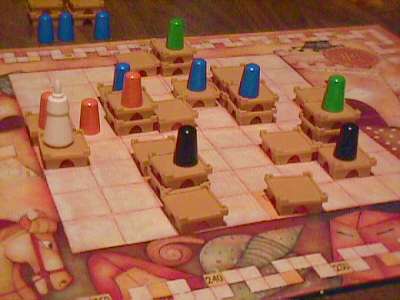
Torres players try to build castles (the objects on the board made up of flat brown pieces in the photo above) and to place knights (the coloured pawns) on the highest levels of the castles that cover the most squares on the board. Players score by multiplying the area of a castle one of their knights inhabits by the level the knight is on. There are a few fiddly rules, such as the one stating that you can only score once per castle, and the bonus from a visit by the King (the tall white pawn), but "height times area" is the essential scoring rule.
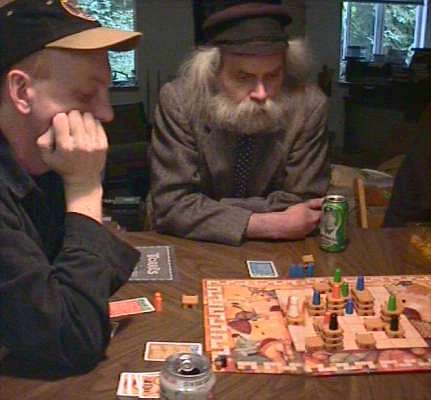
John is a former chess master with an excellent strategic mind, and is renowned for taking an enormously long time on his turns, muttering to himself about "tactical motifs" and "maximisation", and complaining he doesn't understand the rules (usually an attempt to disguise himself as a common gamer and avoid leader-bashing), then going on to win the game in question handily. Tim has not played many games with John and so is not used to this phenomenon. You can see him above looking bored out of his mind. Fortunately, he is a dog lover, as all decent, upright human beings ought to be, and our dogs Tia and Gwenyth provided him some amusement.
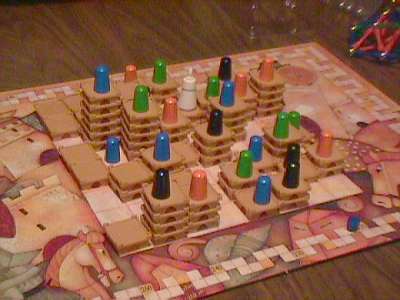
Of course, John won Torres. Abstract games like Chess and semi-abstract ones like Torres are his forte. Final scores were as follows:
John (Blue) ....... 221 Tim (Orange) ...... 198 Ron (Green) ....... 188 Marty (Black) ..... 178
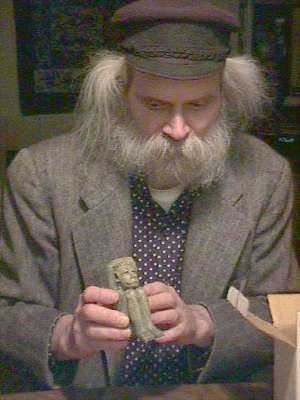
Because of the medieval theme of Torres, we awarded John a small gargoyle statuette (above). Good going, John!
After their two Axiom games, Karl and Alan played a game of Focus, a game that is arguably three-dimensional and that we hadn't even considered for 3D Night. Focus was designed by Sid Sackson, and I consider it one of the great games of the 20th century. I won't say much more about it, but will point you to the rules for Focus in HTML and PDF formats. (Don't be confused by the fact that the rules call the game "Domination"; it's the same game.)
Karl won the Focus game. He is a mean Focus player; I have played many games with him and have never won. The only person I have ever seen beat him in a two-player game of Focus is SC's master strategist John Braley. (See the newsletter for an earlier game night, The Night of Intense Focus. Of course, Paul Unwin, Marty, and John were well on the way to whupping his ass during the four player Focus game that night, before it was indefinitely postponed...)
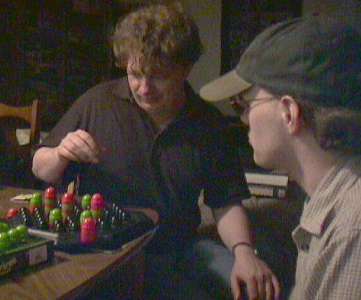
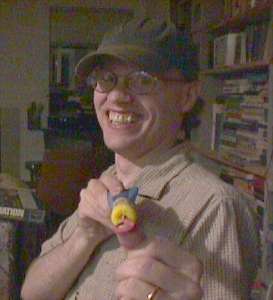
For Karl's victory, he was awarded a Mini Sling Shooter Rocket, a Nerfoid gizmo that you can shoot at people using a little rubber band on its nose. The instructions warn, "NEVER AIM OR SHOOT AT PEOPLE OR ANIMALS." What's the fun of that? The consensus of the group was that you should instead aim AND shoot. In photo 2 above, you can see Karl doing so at cameraperson Marty, who has no head this week.
Kisa arrived around 10:00, on the last turn of the last phase of Torres. We took a break, and then four of us (Tim, Ron, John, and Kisa, with Marty sitting out) started to play Spiel & Deal. Spiel & Deal is a clone of the rare game Kohle, Kie$ & Knete. (You can download Spiel & Deal for free from the Web, and find a rules translation of KK&K for comparison.) This was the first time any of us had played Spiel & Deal, although three of us, counting Marty, had played KK&K last week.
Why hasn't Rio Grande or someone reprinted KK&K? The game is much in demand, and anyone who reprinted it would literally make a heap of Kohle, Kie$ & Knete (English: "Boodle, Buck$ & Bread")! They would have to be careful, however; KK&K has been criticised for antisemitic stereotypes, although I find the character Ronny Raffzahn, who is depicted as a big fat slob, more offensive than any of the supposed Jewish stereotypes. (Then again, Ronny Raffzahn's picture bears a strong resemblance to myself, Ron Hale-Evans, IMHO. Marty will neither confirm nor deny this.)
In Spiel & Deal, instead of trying to make money by sealing financial transactions with negotiations to gather rich investors, you attempt to gain Prestige Points by hosting a game night with negotiations to gather various games. Everyone present who had played KK&K judged Spiel & Deal to be fun, but inferior to the original. One of Spiel & Deal's major flaws is that Masterpiece and Prototype cards (the equivalent of Investor cards in KK&K) cannot be stolen from other players, as Investor cards can be in KK&K. This means that people can end up with multiple Masterpiece/Prototype cards and no one else can do anything about it. It also makes the game less frenetic, which is part of the fun of KK&K. Still, whaddaya want for nothin'? Rubber biscuit? I think AndAgainMA Games is performing a terrific service by essentially making a rare game available for free.
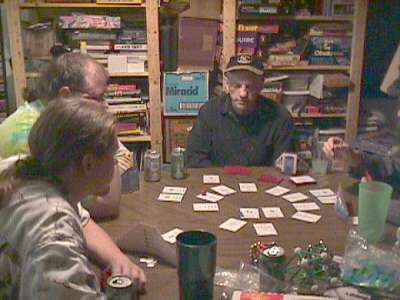
I won an early auction for a Prototype card, and John won the next three auctions, so I had two Masterpiece/Prototype cards and John had four, permanently. This was not necessarily to our favour, however; John was shut out of many deals because people knew he could host almost any game night by himself, and people tended to shut me out a little too. In the end, it was Tim who won; he had managed to keep track of who had the most points better than anyone else had, and thus played more savvily. Having only one Masterpiece/Prototype card did not seem to be a hindrance to him; he was rarely shut out of a deal. John, who came in second, remarked later that he had violated one of his own rules: never take the lead too early, or you will be leader-bashed.
Final scores for Spiel & Deal were as follows:
Tim ..... 67 John .... 45 Ron ..... 39 Kisa .... 35
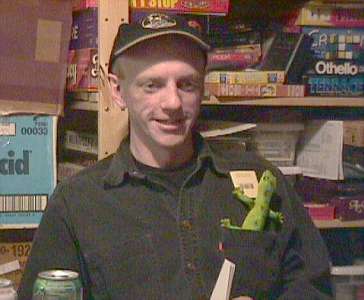
Tim was awarded another toy lizard; I guess you could call this the Night of the Iguana. When he left Saturday, I promised to split the Prestige Points for our real-life game night with him, since he had brought Torres and Modern Art (from which we stole various components for Spiel & Deal). "Don't bother," he said, "I got them all."
By the way, if you think it's unfair of AndAgainMA Games to "rip off" Sid Sackson's game KK&K, I suggest you read these pages, and also consider that Kramer and Kiesling seem to have "ripped off" Strata 5 for Torres, which won the Spiel des Jahres 2000 (see description of Strata 5 below).
Next up, Karl and Alan played a game of Hydra for Two with my Orion set. Orion is an oldish "game system": that is, a set of game equipment with which you can play multiple games, just as you can with an ordinary deck of playing cards or an Icehouse set. Although this game system is little known, it is popular with our group. In an ongoing poll about which games we should play on the Seattle Cosmic mailing list, with seven people voting, Orion is currently one of about five games (out of more than 60) to receive five votes; every voter who had ever played it wants to play it again.
Orion consists of a plastic board with a 5x5 array of rotors. Each rotor can contain up to four flat, eye-shaped pieces of various colours, and the rotors interlock so that rotating one rotor passes the piece you are moving (as well as other pieces on the same rotor) to another one. With the right sequence of rotations, you can shuttle a piece across the board. In Hydra for Two (we played Hydra for Four at game night a couple of months ago), you try to connect the top and bottom of the board with an unbroken chain of pieces of your own colour.
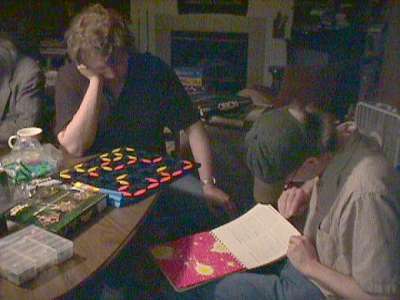
Karl beat Alan at two games of Hydra. For his first victory he was awarded a squeaky, foam rubber rock that fascinated our dog Gwenyth. (Marty noted that there was no warning on the package saying it should not be aimed at people or animals.) For Karl's second victory, he was awarded a package of For Corners, a kind of clear plastic tape designed for repairing the corners of cardboard boxes -- very useful for gamers.
After Spiel & Deal and Hydra for Two, things wound down. Some people left around 12:30 AM and the rest of us chatted until about 2:00, and then everybody went home. No one wanted to play Strata 5 with me at game night proper (Strata 5 being one of the three 3D games we originally intended to play), so Marty took me up on an offer of a game the next day, and I shot photos for your edification.
Because of its three-dimensionality, Strata 5 bills itself as "a strategy game with a daring new dimension". Marty remarked that our game actually had a daring nude dimension, since one of us was playing naked. Do you dare to guess which? (All entries must be postmarked by July 1, 2001.)
Strata 5 (which should be called "Stratum 5", by the way; "strata" is plural, but don't get me started), was published by Milton Bradley in 1984. It is much better than it looks. I am gradually learning that Milton Bradley, Parker Brothers, and other large "vanilla" game companies have actually published some decent games down the years; it's just that few of them have received much attention, the public preferring Monopoly overlaid with every possible theme (Star Wars Monopoly, Warner Brothers cartoon Monopoly, Monopoly for [your city here]), and other bland games, which means that fewer games of quality are published. A consensus seems to be arising on the Spielfrieks mailing list that however inappropriate some of the choices have been lately, and however often they have dissed geniuses like Reiner Knizia, the Spiel des Jahres has helped the game scene in Germany tremendously by providing national recognition for quality games.
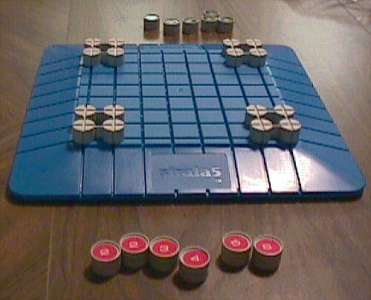
It seems to me that Strata 5 might actually be one of the inspirations for Torres; the mechanisms are strikingly similar. On your turn in Strata 5, you move two pawns, then add a grey building block to the board; this multiple-action turn is similar to Torres, except that the latter gives you a choice of things to do, and an "Action Point" budget with which to do them. Just as in Torres, you can only move up one level at a time, and you cannot hop over another pawn; however, Strata 5 lets you capture opposing pawns by landing on them by exact count (a mechanism several of us fervently wished Torres had when we were playing John). The other main differences are that Torres has cards to let you take special actions that are normally forbidden, and the Strata 5 scoring mechanism is simpler: you just want to land one pawn on the fifth level, rather than gain the most points by multiplying the height of your pawns by the areas of their castles.
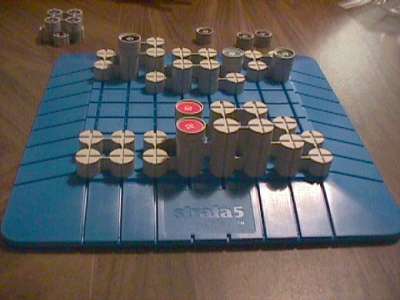
In our game, I played Red and Marty played Black. One interesting detail you'll notice in the closeup below is that it's possible to place blocks in such a way that you cannot place another block between them, effectively isolating one part of the board from another temporarily, even though both parts are right next to each other.
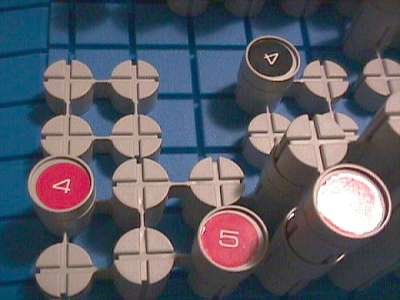
In the end, I conceded the game to Marty. It was a close game; she would have won after I took my turn, although if she hadn't, I would have won on the turn after that. Afterwards, we compared notes. The strategy hints in the rule booklet suggest that you sacrifice your lower-numbered pawns and build on top of them, because the higher-numbered pawns can/must move farther and are supposedly more mobile. We found that actually, as in Focus, it's the lower-numbered pawns that are more mobile; the higher-numbered ones are unwieldy, like trying to slice a sandwich with a two-handed sword.
We also noted there was little player interaction in our game; although you can capture opposing pawns, neither of us did, because our sections of the board were so isolated -- it seemed more efficient to build up rather than out. Marty considered this a flaw in the game design; she thought there should be stronger incentives for a more directly competitive play style. Without it, the opportunity to capture your opponent's pawns is just a meaningless frill. In any case, compare our final position below with the box cover; if our layout had looked more like the one on the box, we would have done more capturing. I'm sure there is still much to learn about this game.
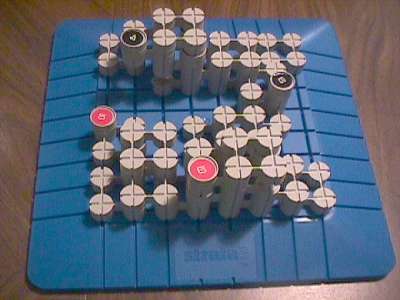
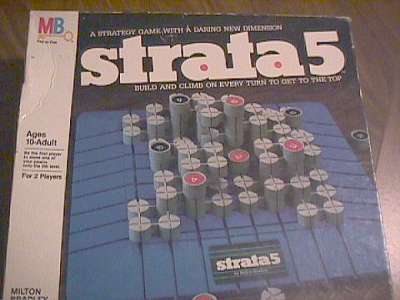
And so our first Theme Night actually ended around 4:00 PM the next day. We remarked that there is one well-known 3D game that we did not play: Upwords, a Scrabble-like game in which you can change the words on the board by building over letter tiles with other ones, up to five high. (Both Strata 5 and Upwords therefore prove the Law of Fives.) David Parlett praises Upwords highly in his Oxford History of Board Games. Oh well; maybe we can play it at the next 3D Game Night, if there is one.
Come to think of it, what should our next Theme Night be? All entries must be postmarked by...
Marty and I just played Axiom for the first time. We played three games. It took us five minutes. The first game, I beat Marty in two turns. The second game, Marty beat me in two turns, and the third game, she beat me in four turns. Considering the difference in length between our games and the ones Karl and Alan played, Axiom really does live up to its billing on the box: "two minutes to two hours". Still, if Karl and Alan hadn't instituted a "you can't move into 'check'" rule, I guess their games might have lasted about as long as ours did.
The Center for Ludic Synergy and Seattle Cosmic Game Night are now associates of Funagain Games. This means that 5% of your purchase there goes toward supporting us if you buy games via the following links or the Funagain logo at the bottom of the page.
Even if you don't want to buy the games, the Funagain pages often contain lengthy, useful game reviews.
Friday, 6 July 2001, 7:00 PM in West Seattle. Come play for fun and FABULOUS PRIZES!
Remember, game nights are first and second Fridays at 7:00 PM, at Dave and Kathy's house in West Seattle, and third and fourth Saturdays at 7:00 PM, at Marty and Ron's apartment in Kent. Please bring a snack or drink to share (cookies, chips, soda, juice, etc.).

Seattle Cosmic Game Night Home | Center for Ludic Synergy home
All photos on this page copyright © 2001 by Ron Hale-Evans except where otherwise noted.
Maintainer: Ron Hale-Evans, rwhe@ludism.org
Page last updated 25 June 2001.